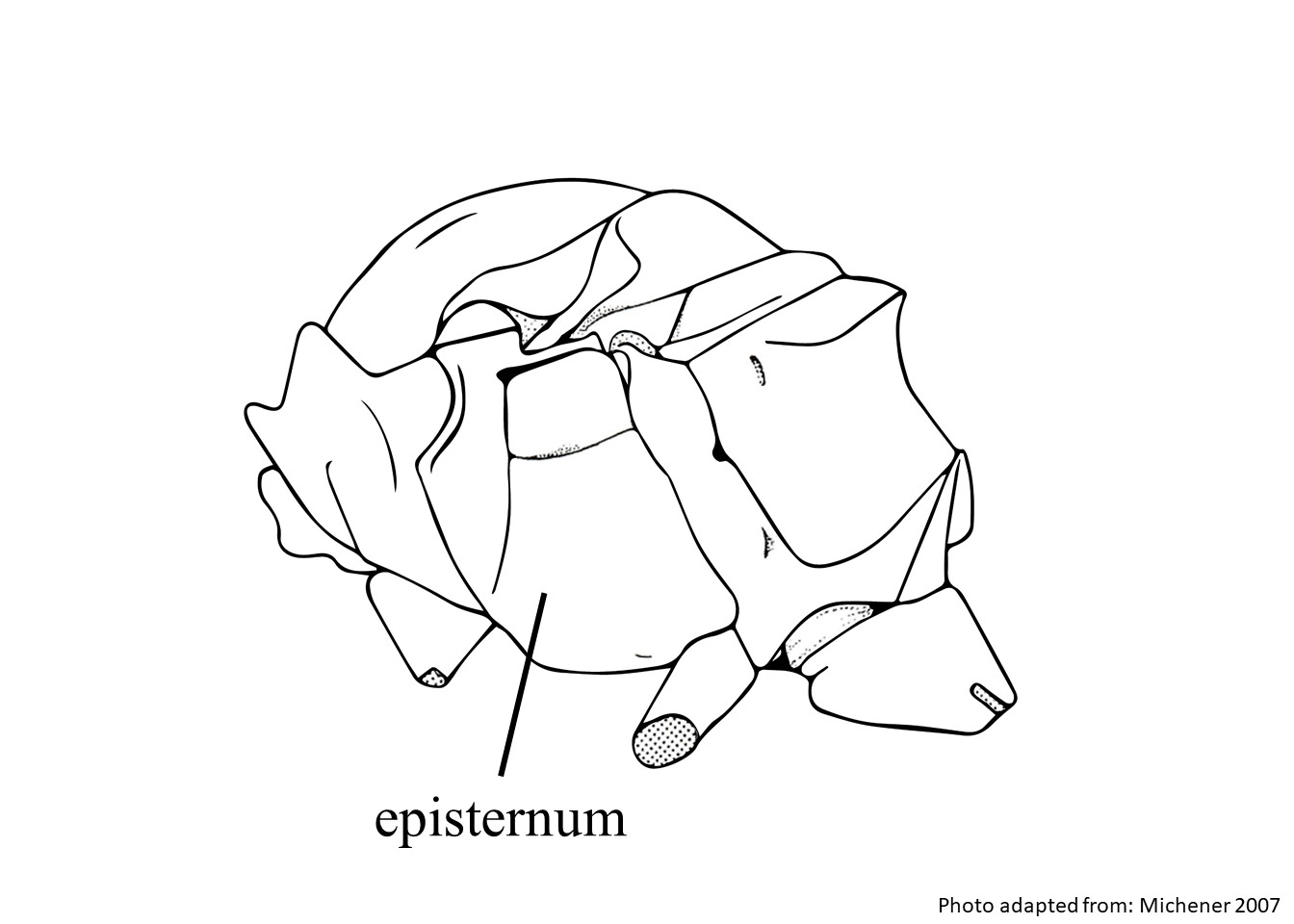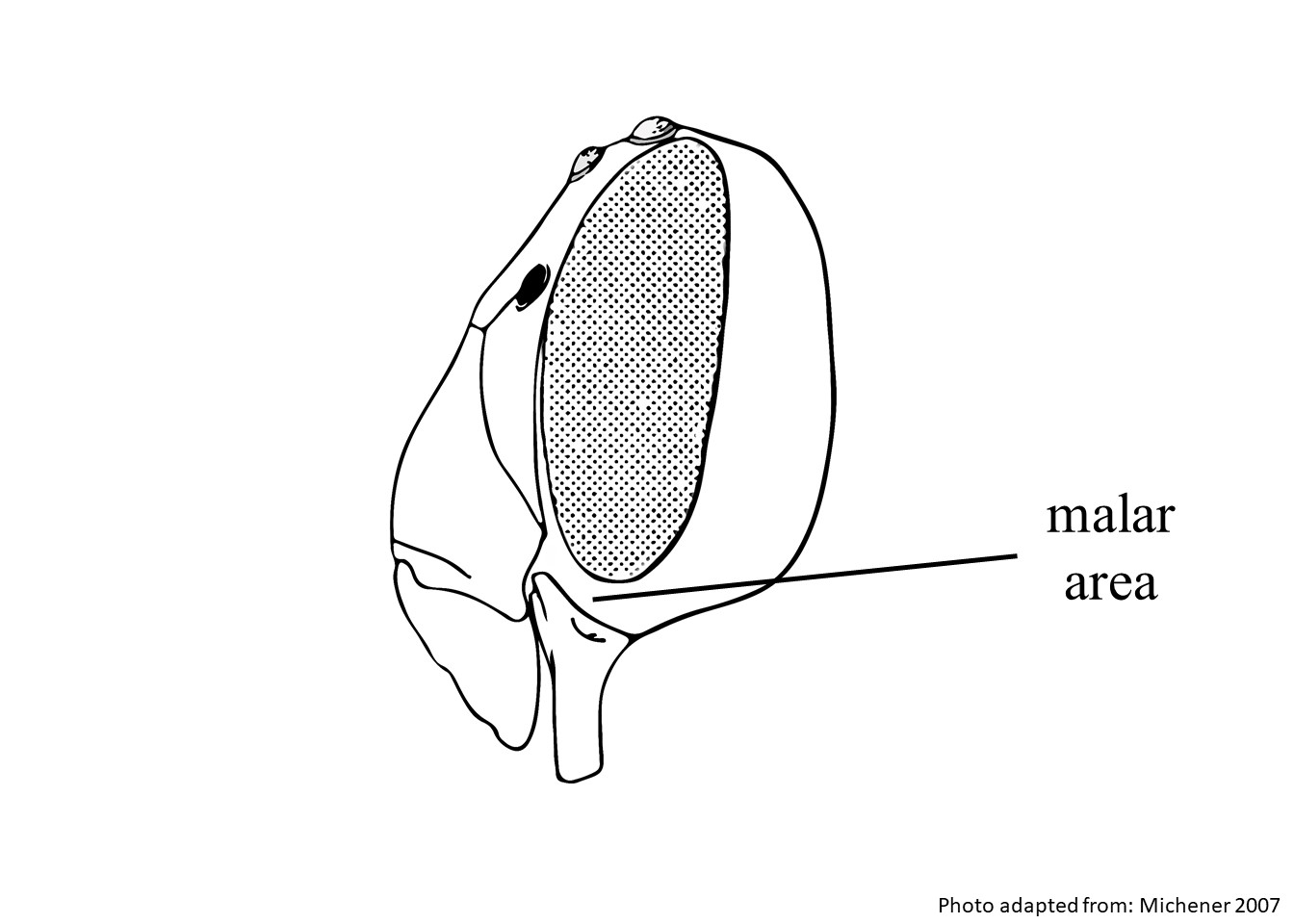Family: Megachilidae
Subfamily: Megachilinae
Tribe: Osmiini
Genus: Osmia Panzer, 1806
Subgenus: O. (Osmia) Panzer, 1806
Species: Osmia lignaria Say, 1837
Common name: blue orchard bee
Osmia (Osmia) lignaria are dark metallic blue bees. They have a pale blue face that is covered with a mixture of white and black hair. The thorax has intermixed pale and black hair on the scutumscutum:
the large segment on top of the thorax located between the wings and behind the head
and primarily black hair on the episternumepisternum:
the lateral or side areas of the thorax, excluding the lateral surfaces of the propodeum
 . T1T1:
. T1T1:
the segments on the top side of the abdomen, often abbreviated when referring to a specific segment to T1, T2, T3, T4, T5, T6, or T7 and sometimes T2T2:
and sometimes T2T2:
the segments on the top side of the abdomen, often abbreviated when referring to a specific segment to T1, T2, T3, T4, T5, T6, or T7 are covered in white hair, and the remaining tergaterga:
are covered in white hair, and the remaining tergaterga:
the segments on the top side of the abdomen, often abbreviated when referring to a specific segment to T1, T2, T3, T4, T5, T6, or T7 are covered with primarily black hair (Fig 6). Female body length is 7–13 mm, and male body length is 9–11 mm (Sandhouse 1939Sandhouse 1939:
are covered with primarily black hair (Fig 6). Female body length is 7–13 mm, and male body length is 9–11 mm (Sandhouse 1939Sandhouse 1939:
Sandhouse, G.A. 1939. The North American bees of the genus Osmia (Hymenoptera: Apoidea). The Entomological Society of Washington, Washington, D.C.: 1ndash;172.; Rust 1974Rust 1974:
Rust, R.W. 1974. The systematics and biology of the genus Osmia, subgenera Osmia, Chalcosmia, and Cephalosmia. Wasmann Journal of Biology 32: 1ndash;93.).
(from Sandhouse 1939Sandhouse 1939:
Sandhouse, G.A. 1939. The North American bees of the genus Osmia (Hymenoptera: Apoidea). The Entomological Society of Washington, Washington, D.C.: 1ndash;172.; Rust 1974Rust 1974:
Rust, R.W. 1974. The systematics and biology of the genus Osmia, subgenera Osmia, Chalcosmia, and Cephalosmia. Wasmann Journal of Biology 32: 1ndash;93.)
 without apicalapical:
without apicalapical: has a projection or lobate process.
has a projection or lobate process.Osmia lignaria be distinguished from other Osmia (Osmia) by its distinct blue-green hue in combination with the distinctly projected malar spacemalar space:
the shortest distance between the base of the mandible and the margin of the compound eye
 in females and the subtriangular projection on the middle femurfemur:
in females and the subtriangular projection on the middle femurfemur:
the third segment of the leg, situated between the trochanter and the tibia
in males (Rust 1974Rust 1974:
Rust, R.W. 1974. The systematics and biology of the genus Osmia, subgenera Osmia, Chalcosmia, and Cephalosmia. Wasmann Journal of Biology 32: 1ndash;93.). There are, however, two subspecies in the U.S., O. lignaria lignaria and O. lignaria propinqua, which can be more difficult to tell apart. Female O. lignaria lignaria can be distinguished from O. lignaria propinqua by their tridentatetridentate:
having three teeth
mandibles and the short laterallateral:
relating, pertaining, or attached to the side
horns on their clypeusclypeus:
a section of the face below the antennae, demarcated by the epistomal sutures (Rust 1974Rust 1974:
Rust, R.W. 1974. The systematics and biology of the genus Osmia, subgenera Osmia, Chalcosmia, and Cephalosmia. Wasmann Journal of Biology 32: 1ndash;93.). Males do not have reliable characters to distinguish between the subspecies (Rust 1974Rust 1974:
Rust, R.W. 1974. The systematics and biology of the genus Osmia, subgenera Osmia, Chalcosmia, and Cephalosmia. Wasmann Journal of Biology 32: 1ndash;93.).
Osmia lignaria adults have been recorded in flight in every month except for November (GBIF 2019dGBIF 2019d:
GBIF.org. 12 July 2019. GBIF Occurrence Download. https://doi.org/10.15468/dl.2gbgt2). In the U.S. O. lignaria have been collected in the spring, from March to June (Rust 1974Rust 1974:
Rust, R.W. 1974. The systematics and biology of the genus Osmia, subgenera Osmia, Chalcosmia, and Cephalosmia. Wasmann Journal of Biology 32: 1ndash;93.).
Osmia lignaria are polylecticpolylectic:
bees that collect pollen from the flowers of a variety of unrelated plants
(Torchio 1976Torchio 1976:
Torchio, P.F. 1976. Use of Osmia lignaria Say (Hymenoptera: Apoidea, Megachilidae) as a pollinator in an apple and prune orchard. Journal of the Kansas Entomological Society 49: 475ndash;482.). Osmia lignaria are used to pollinate apple, plum, cherry, and almond trees (Torchio 1976Torchio 1976:
Torchio, P.F. 1976. Use of Osmia lignaria Say (Hymenoptera: Apoidea, Megachilidae) as a pollinator in an apple and prune orchard. Journal of the Kansas Entomological Society 49: 475ndash;482.; Bosch et al. 2000Bosch et al. 2000:
Bosch, J., W.P. Kemp, and S.S. Peterson. 2000. Management of Osmia lignaria (Hymenoptera: Megachilidae) populations for almond pollination: methods to advance bee emergence. Environmental Entomology 29: 874ndash;883.; Bosch et al. 2006Bosch et al. 2006:
Bosch, J., W.P. Kemp, and G.E. Trostle. 2006. Bee population returns and cherry yields in an orchard pollinated with Osmia lignaria (Hymenoptera: Megachilidae). Journal of Economic Entomology 99: 408ndash;413.). They have also been observed visiting currant, dandelion, white clover, hawthorn, and rose (Torchio 1976Torchio 1976:
Torchio, P.F. 1976. Use of Osmia lignaria Say (Hymenoptera: Apoidea, Megachilidae) as a pollinator in an apple and prune orchard. Journal of the Kansas Entomological Society 49: 475ndash;482.; Phillips and Klostermeyer 1978Phillips and Klostermeyer 1978:
Phillips, J.K. and E.C. Klostermeyer. 1978. Nesting behavior of Osmia lignaria propinqua Cresson (Hymenoptera: Megachilidae). Journal of the Kansas Entomological Society 51: 91ndash;108.).
Osmia lignaria often nests in abandoned burrows and hollow stems (Guisse and Miller 2011Guisse and Miller 2011:
Guisse, J.K and D.G. Miller. 2011. Distribution and habitat preferences of Osmia lignaria (Hymenoptera: Megachilidae) and associated cavity-nesting insects in Californiarsquo;s Sierra Nevada foothills adjacent to the Sacramento Valley. The Pan-Pacific Entomologist 87 (3): 188ndash;195.) . O. lignaria will also nest in man-made nesting materials, such as hollow nesting tubes or drilled wood blocks, allowing them to be collected and transferred to commercial orchard environments (Torchio 1976Torchio 1976:
Torchio, P.F. 1976. Use of Osmia lignaria Say (Hymenoptera: Apoidea, Megachilidae) as a pollinator in an apple and prune orchard. Journal of the Kansas Entomological Society 49: 475ndash;482.; Torchio and Asensio 1985Torchio and Asensio 1985:
Torchio, P. and E. Asensio. 1985. The introduction of the European bee, Osmia cornuta Latr, into the US as a potential pollinator of orchard crops, and a comparison of its manageability with Osmia . Journal of the Kansas Entomological Society 58: 42ndash;52.). Each nest cavity contains multiple cells separated by mud partitions (Guisse and Miller 2011Guisse and Miller 2011:
Guisse, J.K and D.G. Miller. 2011. Distribution and habitat preferences of Osmia lignaria (Hymenoptera: Megachilidae) and associated cavity-nesting insects in Californiarsquo;s Sierra Nevada foothills adjacent to the Sacramento Valley. The Pan-Pacific Entomologist 87 (3): 188ndash;195.).
Osmia lignaria is native to North America and split into two subspecies: O. lignaria propinqua which is found west of the 100th meridian, and O. lignaria lignaria which is found east of the 100th meridian (Guisse and Miller 2011Guisse and Miller 2011:
Guisse, J.K and D.G. Miller. 2011. Distribution and habitat preferences of Osmia lignaria (Hymenoptera: Megachilidae) and associated cavity-nesting insects in Californiarsquo;s Sierra Nevada foothills adjacent to the Sacramento Valley. The Pan-Pacific Entomologist 87 (3): 188ndash;195.). All populations occur between sea level and 2000 m (Guisse and Miller 2011Guisse and Miller 2011:
Guisse, J.K and D.G. Miller. 2011. Distribution and habitat preferences of Osmia lignaria (Hymenoptera: Megachilidae) and associated cavity-nesting insects in Californiarsquo;s Sierra Nevada foothills adjacent to the Sacramento Valley. The Pan-Pacific Entomologist 87 (3): 188ndash;195.). O. lignaria are known to occur from the northern edge of Mexico to the southern half of Canada (Rust 1974Rust 1974:
Rust, R.W. 1974. The systematics and biology of the genus Osmia, subgenera Osmia, Chalcosmia, and Cephalosmia. Wasmann Journal of Biology 32: 1ndash;93.). O. lignaria have also been documented in orchard fields in Spain, but it is unknown if they have become established (Ortiz-Sanchez 2011Ortiz-Sanchez 2011:
Ortiz-Sanchez, F.J. 2011. Lista actualizada de lase species de abejas de Espana (Hymenoptera: Apoidea: Apiformes). Boletin de la Sociedad Entomologica Aragonesa 49: 265ndash;281.).
Distribution map generated by Discover Life -- click on map for details, credits, and terms of use.
Bosch, J., W.P. Kemp, and S.S. Peterson. 2000. Management of Osmia lignaria (Hymenoptera: Megachilidae) populations for almond pollination: methods to advance bee emergence. Environmental Entomology 29: 874-883.
Bosch, J., W.P. Kemp, and G.E. Trostle. 2006. Bee population returns and cherry yields in an orchard pollinated with Osmia lignaria (Hymenoptera: Megachilidae). Journal of Economic Entomology 99: 408-413.
GBIF.org. 12 July 2019. GBIF Occurrence Download https://doi.org/10.15468/dl.2gbgt2
Guisse, J.K and D.G Miller. 2011. Distribution and habitat preferences of Osmia lignaria (Hymenoptera: Megachilidae) and associated cavity-nesting insects in California’s Sierra Nevada foothills adjacent to the Sacramento Valley. The Pan-Pacific Entomologist 87(3): 188–195.
Ortiz-Sanchez, F.J. 2011. Lista actualizada de lase species de abejas de Espana (Hymenoptera: Apoidea: Apiformes.) Boletin de la Sociedad Entomologica Aragonesa 49: 265-281.
Phillips, J.K. and E.C. Klostermeyer. 1978. Nesting behavior of Osmia lignaria propinqua Cresson (Hymenoptera: Megachilidae). Journal of the Kansas Entomological Society 51: 91-108.
Rust, R.W. 1974. The systematics and biology of the genus Osmia, subgenera Osmia, Chalcosmia, and Cephalosmia (Hymenoptera: Megachilidae). Wasmann Journal of Biology 32: 1-93.
Sandhouse, G.A. 1939. The North American bees of the genus Osmia (Hymenoptera: Apoidea). The Entomological Society of Washington, Washington, D.C.: 1-172.
Torchio, P.F. 1976. Use of Osmia lignaria Say (Hymenoptera: Apoidea, Megachilidae) as a pollinator in an apple and prune orchard. Journal of the Kansas Entomological Society 49: 475-482.
Torchio, P.F. and E. Asensio. 1985. The introduction of the European Bee, Osmia cornuta Latr., into the U.S. as a potential pollinator of orchard crops, and a comparison of its manageability with Osmia lignaria propinqua Cresson (Hymenoptera: Megachilidae). Journal of the Kansas Entomological Society 58: 42-52.